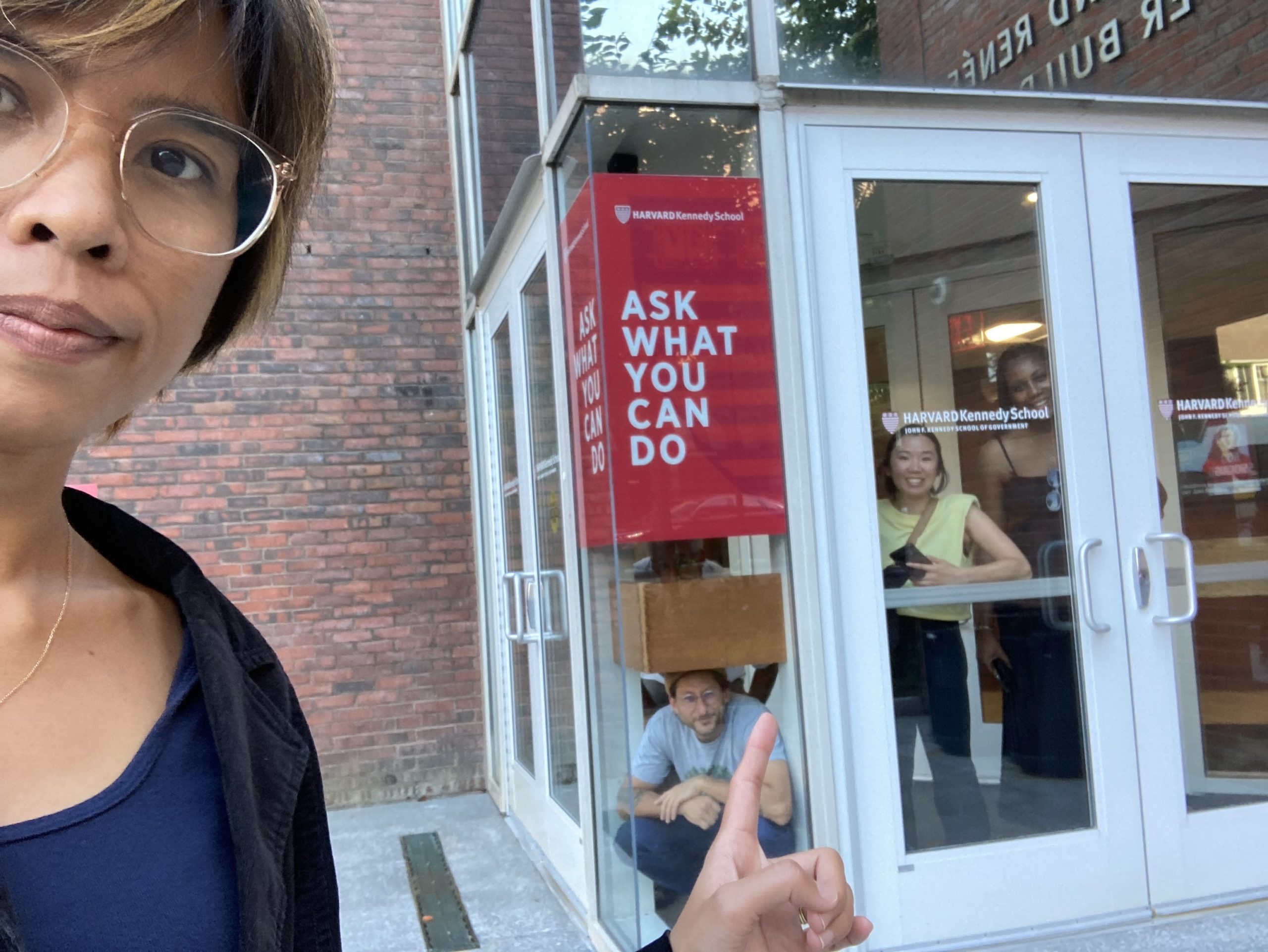Nieman Journalism Lab

For the past 14 years, the Nieman Journalism Lab has served as an essential resource for a worldwide audience of loyal readers and analysts looking for original reporting, research and commentary on developments and rapidly changing norms in the news and media industries. The Lab continues to provide incisive reporting about the future of news, innovation and best practices in the digital space.
In 2022, Nieman Lab continued to provide valuable and innovative daily coverage of the ever-changing world of digital news. Laura Hazard Owen is editor. Sarah Scire was promoted to deputy editor in August. Joshua Benton is senior writer, Hanaa’ Tameez is a staff writer and Nieman Lab is currently (December 2022) accepting applications for another staff writer position. Daily coverage is rounded out with contributions from a diverse and growing group of freelancers.
The Lab’s goals remain to help reporters and editors adjust to their online environment; to help legacy news organizations find a way to survive and succeed; and to cover the new crop of startups and technologies that increasingly complement or supplant them. We continue to focus our lens on diversity in media and how newsrooms are grappling with shifting notions of objectivity and transparency — and we are making an impact. This year, Sarah Scire’s reporting on newsrooms’ “crushing resistance” to completing an annual diversity survey by the News Leaders Association inspired a petition to the Pulitzer Prize board that was signed by 180 news organizations and 357 individuals, while Hanaa’ Tameez’s investigation into race-related roles in newsrooms two years after the murder of George Floyd led to speaking engagements in newsrooms.
We continue to act as a bridge between academics and readers by distilling the latest journalism research for our audience. This year, Lab members collaborated with a doctoral student to study the relationship between practicing journalists and academic researchers and deputy editor Sarah Scire was invited to present some early findings to researchers at the annual AEJMC meeting held in Detroit over the summer.
In 2022, we also enjoyed a return to in-person events. Lab members attended and moderated or spoke at the International Symposium on Online Journalism, Newsgeist, and LION’s Independent News Sustainability Summit.
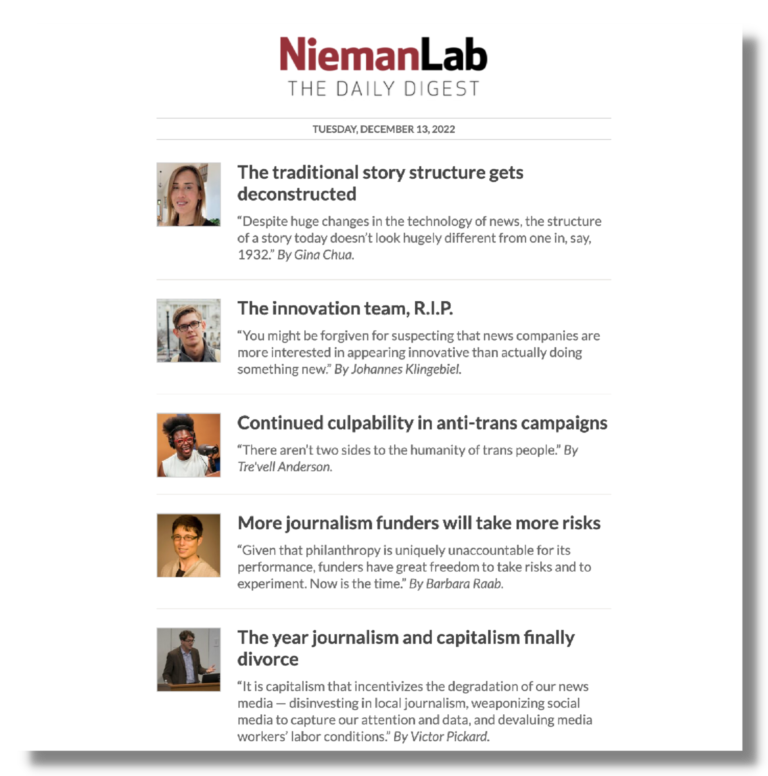
The Lab’s most important social outreach platform remains email, with its daily and weekly email newsletters reaching more than 87,000 people. The Lab’s social accounts on Twitter, Facebook, and LinkedIn have nearly 500,000 followers among them. Nieman Lab stories are also regularly cited by dozens of leading publications; this year our coverage was mentioned by The New York Times, The Washington Post, The New Yorker, Vanity Fair, CNN, On the Media, Platformer and Democracy Now!, and was regularly featured in industry press outlets like Columbia Journalism Review, American Press Institute, Pew and Poynter.

Here’s a sampling of the top stories Nieman Lab published this year:
- Meta’s layoffs make it official: Facebook is ready to part ways with the news
- Unimaginable abortion stories will become more common. Is American journalism ready?
- American journalism’s racial reckoning still has lots of reckoning to do
- The New York Times would really like its reporters to stop scrolling and get off Twitter (at least once in a while)
- Some resources for following the invasion of Ukraine
- A time before Wordle: Newspapers used to hate word puzzles
- “‘The truth’ was not true”: Two journalists are using unsealed documents and social media to reconstruct gray areas of Mexican history
- “Space is for everyone”: Meet the scientists trying to put otherworldly images into words
- For print newspapers, one Florida retirement community is a better market than Atlanta, St. Louis, or Portland
Areas of focus for 2023 are likely to include news organizations’ shifting relationships with platforms, new technologies like AI-generated art and alternative social platforms for news, consolidation in the digital news space, newsrooms’ expansions into non-news products and new payment models.

The year ended, as it has each year since 2011, with a collection of predictions for the new year in journalism, written by a diverse group of smart digital thinkers and doers.
Nieman Reports

As we look back at how the news industry fared throughout 2022, many of the same themes from years past remain relevant. Press freedoms around the globe were at risk in dozens of countries, most notably Russia, after the government passed so-called “fake news” laws to discourage truthful reporting on the invasion of Ukraine, and Iran, where journalists have been jailed for covering the uprisings after the death of Mahsa Amini.
Trust in media decreased to a near-record low, and newsrooms were still grappling with how to both diversify their ranks and ensure their coverage reflected the communities around them. The decimation of the local news landscape continued as corporate consolidations and closures created more news deserts across the United States. Throughout the year, Nieman Reports, which has been covering thought leadership in journalism since 1947 with an editorial mission “to promote and elevate the standards of journalism,” published insightful, timely, and deeply reported analyses of and commentary on these issues and more.
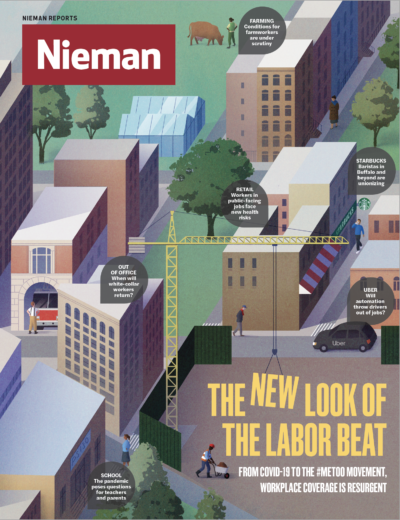
In “From Covid-19 to #MeToo, The Labor Beat Is Resurgent,” Steven Greenhouse, a former New York Times labor reporter, delves into how the beat, which had atrophied over several decades, is making a comeback and leading to more front-page stories about workplace safety, unionization, and remote work arrangements. Steven also wrote a companion piece — Newsrooms Are Unionizing Pretty Much “Nonstop.” Here’s Why — about how the pandemic and ongoing consolidation within the industry has fueled the drive within newsrooms to unionize. We also feature reporting on why news outlets need to invest in consistent voting rights reporting to counterbalance the push in some states to restrict ballot access and how podcasts are popping up across Europe to tackle issues of race and racism — topics the mainstream media have been slow to address. We also published two international pieces, one on the last few bastions of independent media in India and the other on how exiled journalists are fighting to keep information about Myanmar flowing freely despite the latest military crackdown.

Nieman Reports focused on press freedom in the wake of Russia’s full-scale invasion of Ukraine. Several stories deal specifically with the dangers facing journalists reporting on the conflict. One piece, “Covering the War in Ukraine: ‘The Putin Regime Doesn’t Want Eye Witnesses,” explores how few Ukrainian journalists had experience operating in a conflict zone. Issac Bailey, NF ’14 and regular columnist for Nieman Reports, calls out the double standard in how the media covered Ukrainian refugees — who are mostly white — compared to refugees from the Middle East or Africa. Our feature about immigration coverage argues that news organizations need to center the lives of immigrants in their stories, not fall back into the political framing of whether a development hurts or helps a particular political party. We also published stories about how to more accurately cover polls by adding more context to survey data, why news organizations should have transparent and public standards describing how they approach polling data, and why audience engagement is an essential part of making progress in diversifying a newsroom.

In our “Reporting at Risk” series we published essays by journalists managing to do vital independent reporting — often at great personal risk. Highlights include “‘We Should Side with Democracy:’ Why the War in Ukraine is Existential for Baltic Journalists,” which looks at how newsrooms in the Baltic states have taken up the post of defending democracy. In Brazil, Natalia Viana, NF ’22, examines the death of Amazon reporter Dom Philips, writing that “It was the virulent anti-media discourse of Jair Bolsonaro that allowed local criminals to feel free to murder and hide the body of an internationally renowned journalist like Dom Phillips.” And on Myanmar, Danny Fenster, NF ’23, highlights the important work of journalists-in-exile who have continued to stand up to the military junta even has they have been forced from their homes. With over a dozen other essays, Reporting at Risk spans countries from Mexico and Russia to the Philippines and Ghana.

In the run up to the midterm elections, “How Political Coverage is Changing to Get Beyond ‘Us Versus Them’” tackled polarization, exploring how newsrooms can advance political coverage that considers voters rather than just vote-seekers, examining divisions without oversimplifying or overstating them, and identifying not only the existence of problems but possible solutions. “Why Journalists Are Centering Trauma-Informed Reporting,” by Julia Craven, demonstrates how and why journalists should take their sources’ mental health into consideration when reporting. In “A ‘Kiss of Freedom’ for Turkey’s Free Press,” Emre Kizilkaya, a 2019 Visiting Nieman Fellow, highlights the independent Turkish newsrooms that have continued to publish despite a crackdown on the free press. Other features include “How to Cover Assassinations — Safely,” written by 2016 Visiting Nieman Fellow Paul McNally and Stefania D’Ignoti’s “Newsrooms Inside Refugee Camps: By Migrants, for Migrants.”
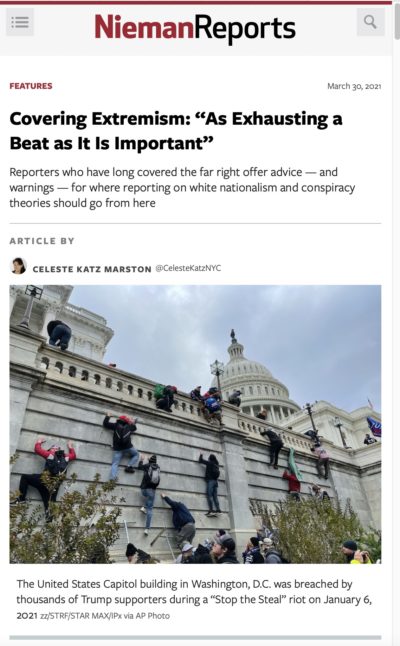
Nieman Reports was named a finalist in this year’s Mirror Awards, which honor excellence in media industry reporting. Contributor Celeste Katz Marston was recognized for her piece, “Covering Extremism: ‘As Exhausting a Beat as It Is Important’” in a special category honoring coverage of the Jan. 6 and the Stop the Steal movement.
This year, Nieman Reports experimented with a wide range of digital and social media strategies. In February, over 600 listeners tuned into Nieman Reports’ first ever Twitter Spaces conversation, which centered on Steven Greenhouse’s piece on the labor beat and featured four prominent labor reporters. Nieman Reports hosted a second Spaces conversation in September in honor of Democracy Day, an initiative of news industry leaders at Hearken, the Center for Cooperative Media, the Institute for Nonprofit News, and the News Revenue Hub to report on threats against U.S. democratic norms — and accompanying threats to the free press. The discussion, which was based on coverage by Celeste Katz Marston, tackled how newsrooms are spearheading democracy reporting by carving out dedicated democracy desks and attracted over 300 listeners. Nieman Reports also created its first ever pop-up newsletter on Democracy Day, sending newsletter subscribers a brief of Nieman Reports’ most important democracy coverage throughout the year.
Under the direction of digital and audience engagement editor Adriana Lacy, Nieman Reports saw an increase in visitors compared to last year. On Facebook, Nieman Reports now reaches over 7,100 followers while on Twitter, followers have increased to over 37,800. Through an audience re-engagement campaign, Twitter ads, and more, Nieman Reports increased its newsletter subscriptions, which now reaches a total of 6,709 subscribers.
The staff that produces Nieman Reports includes editor James Geary, deputy curator of the Nieman Foundation; senior editor Laura Colarusso; assistant editor Natalie De Rosa; and publisher Ann Marie Lipinski, curator of the Nieman Foundation; with design by Dan Zedek, a Boston-based independent designer.
Nieman Storyboard

The best journalism is a reflection of society in the moment and through time — not just in topic but in tone. Storyboard posts throughout 2022 were a reflection of that journalism.
Some trends:
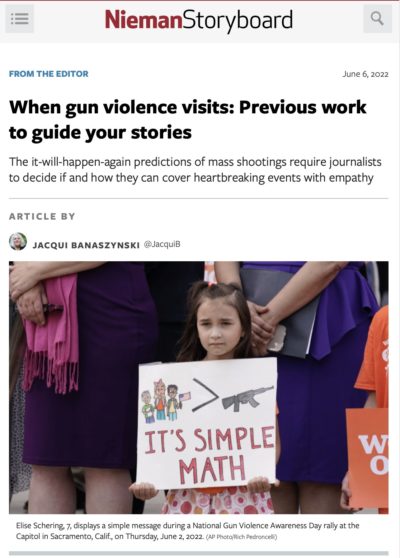
- COVID no longer eclipsed most other news, nor nagged to be the dominant focus of pieces featured on Storyboard. The eclectic range of posts mirrored the eclectic range of top headlines: war in Ukraine; investigations into the 2021 attack on the U.S. Capitol; the stubborn scourge of gun violence; entrenched political divisions and the momentous issues before a revamped U.S. Supreme Court. Of note, three of the four posts in the Supreme Court reporting series ranked among the top 20 of all-time Storyboard posts.
- Stories of trauma continue to weave through the news around the world. A series of interviews with reporters who covered traumatic situations was framed by an essay by award-winning editor and teacher Jan Winburn, who has put sensitivity at the heart of her story work.
- Amplifying unheard or unheeded voices remains vital to standout narrative nonfiction. Storyboard unspooled how a male New Yorker reporter earned trust with women under Taliban rule in Afghanistan. Another post explored the challenges of “emotional truth” in writing from inside prisons.

- The practices of investigative and narrative journalism are merging more and more — a long overdue elevation of both. Storyboard readers learned how Caitlin Dickerson of the Atlantic uncovered the dark heart of America’s immigration policy. They learned about the heartbreaking issue of child suicide through a Q&A with author Andrew Solomon.
- The identity and personality of storytellers is emerging more and more in journalism, perhaps as a sense of intimacy on the internet or perhaps as a desire, from both reporters and readers, for greater transparency. That showed in a significant uptick of published stories that were threaded through with the first person: A business reporter from Bloomberg wrote about helping her father die; a writer at The Atlantic talked to Storyboard about how her cats inspired a series on science.
- Personal essays also drew growing interest from contributors and readers alike. If Storyboard is a reflection of contemporary journalism, it’s also a mirror to those who do that journalism. Followers learned about how a fellow writer handles the ups and downs of feedback, and how another deals with writing the kinds of stories she finds hard to read.
A good share of posts continues to focus on how the work is done: Readers never tire of posts about structure, ethics, editor-reporter relationships and interviewing; a two-part series about what it takes to write and publish a book has led to further posts on everything from writing memoir to the pressure on authors to self-promote. Along with sharing the pain, Storyboard readers value validation: An especially popular piece was from a Ph.D. in literature who argued that journalism is the best way to teach effective writing. Also popular: A continued series on what the mundane tasks of life — from stacking wood to building stone paths to hacking at blackberry brambles to crafting beer — teach us about reporting and writing process.
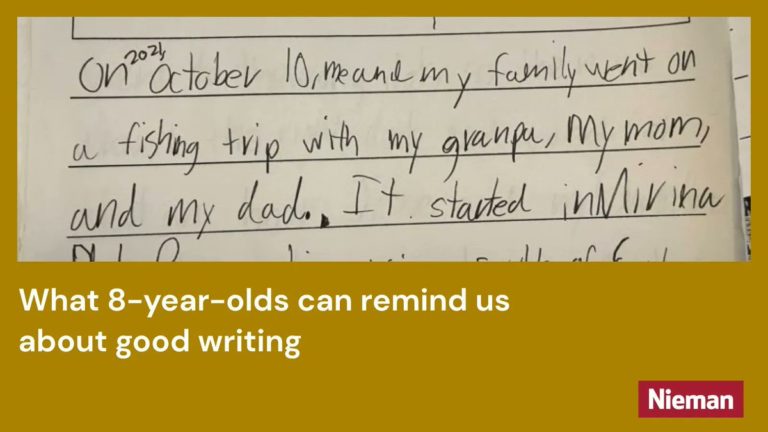
One last important note: This was a year where Storyboard dared to have fun. We carried posts about learning from 8-year-olds, writing engaging PSAs about bears and public safety, profiling a celebrity alligator, writing an irreverent obit and the low art of the pun.
No matter the topic or tone, Storyboard remains committed to providing tools, inspiration and connection to the true storytellers of today and tomorrow. All posts focus on the best practices of the profession, with an eye to both timeliness and timelessness. A special homage was included this year to WriterL, a simple listserv that served, in many ways, as the spark of the deeply reported, beautifully written stories that now tell us about our world.

On social media, due to a strategy emphasizing consistent posting during peak hours and a focus on sharing stories in like-minded online community groups, Storyboard saw an increase in visitors from social media compared to last year. On Facebook, Storyboard’s account reached 5,899 followers while on Twitter, followers increased to 16,654. And the site’s weekly newsletter, which is sent each Friday afternoon, now reaches a total of 13,616 subscribers.
Jacqui Banaszynski is editor of Nieman Storyboard. She was assisted in her work in 2022 by Nieman’s digital and audience engagement editor Adriana Lacy and by Natalie De Rosa, assistant editor of Nieman Reports.
